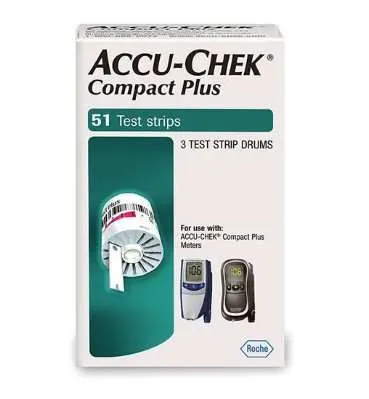100 Accu-Chek Compact Plus Test Strips
$20.00 – $62.00
Reasons to buy

100 Accu-Chek Compact Plus Test Strips
Monitoring blood sugars can be one of the most effective tools in the battle to combat diabetes. The Accu-Chek Compact Plus test strips are designed to help make quick work of your diabetes testing so that you can self-monitor glucose levels effectively. These disposable strips are housed in a load and go drum of 17 which means no more handling of individual strips. A wide contact area allows for easier transfer of droplets, insuring an effective and accurate reading the first time, every time. Stop missing moments in your life because of complicated and time-consuming diabetes testing.
FEATURES
- Wide area of transfer, rather than just one spot
- 10/10 accuracy
- Easy load and go drum – use one and spill none
- 5 micro drop
- Completely disposable
- Use with ACCU-CHEK Compact Plus
- 7 second results
- Automatic coding
- Auto Calibration – insert drum and push a button
- Easy to read
- Designed to read glucose from multiple testing areas – finger, palm, thigh, upper arm, calf.
FAQ Regarding Glucose and Testing
What is Glucose?
Glucose is the amount of sugar in the blood stream. The human body creates insulin (a hormone from the pancreas) which allows sugars to be converted from food so that it can be consumed by the body. These sugars are stored, providing energy for the body to be use as the demands of the body require it.
Why is Glucose Monitoring Important?
Monitoring blood sugar levels is one of the most important things a person with diabetes can do to help prolong their life. Knowing what activities influence glucose levels; exercise, different types of food, and even medicine, can provide the necessary information to create a reasonable treatment plan with your doctor.
How Difficult is Glucose Testing?
With the invent of modern testing methods, most diabetes monitoring is relatively simple. A glucose meter and strips are the primary method most individuals use. The external unit and strips require a droplet of blood to be extracted and placed on the strip. Once the strip is inserted into the meter, a reading can be retrieved in seconds. In the last couple of years, more patients are opting for a surgically attached meter which sends glucose levels directly to a smart phone. Your doctor should help you determine which type of meter is right for you.
What is the Best Glucose Level to Maintain?
According to the American Diabetes Association, the goal is to keep blood sugars less than 180mg/dL, 1-2 hours after the start of a meal, when most people’s glucose levels reach their peak. While blood sugar levels vary from person to person, your doctor can assist you to determining what it right for you.
What is the Difference Between Low and High Blood Sugar?
For most individuals, a glucose reading under 70 mg/dL, is considered low blood sugar or hypoglycemia. When it is about 180 mg/dL, this is called high blood sugar or hyperglycemia.
What Complications can Happen if Blood Sugars are Untreated?
Health complications can occur if blood sugars are not properly monitored. Diabetes is a serious disease that can lead to consequences for health and aging, primarily attacking the efficiency of internal organs. If left untreated, there are increased risks for heart disease and organ failure eventually leading to death.
What are Symptoms of Low Blood Sugar?
The symptoms of depressed sugars in the bloodstream (hypoglycemia) may vary from person to person, depending on the level of glucose and body chemistry. Initial symptoms usually include:
- Hunger
- Jittery feeling
- Increased Anxiety
- Pale skin
- Fast or Irregular Heartbeat
- Sleepiness
- Dizzy
- Mood changes toward Irritability
What are the Symptoms of High Blood Sugar?
The complications of increased blood sugars (hyperglycemia) are –
- High sugar levels
- High concentration of sugar in urine
- Increase Thirst
- Frequent Urination
Effective monitoring of blood sugars can make a significant difference in the quality of life for the diabetic. While every person’s body chemistry is different. Knowing the warning signs and understanding the importance of effective self-monitoring can help a person live their best life possible. As with any medical condition, your doctor should always be consulted regarding any glucose monitoring strategy.
| Quantity | 25, 50, 100 |
|---|
